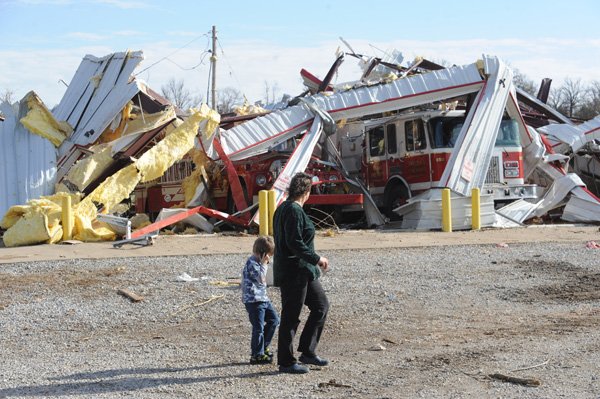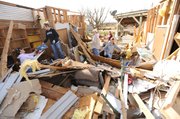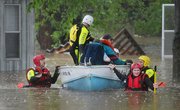Bobby Spears’ weather moment of 2011 hit Jan. 1 as he surveyed the ruins of his community’s fire station.
For Fay Miller, the moment happened April 25 when a neighbor’s son knocked on her door. Behind him, an overflowing creek lapped at her porch. Firefighter Willie Watts struggled all that afternoon to keep up with his dispatchers as calls for rescues increased faster than the water rose.
A month later on May 22, Watts was eating Sunday dinner with his family when a colleague called.
“Turn the television on. We’ve gotta go. Joplin just got leveled.”
Johnny Gunsaulis heard a constant litany of the same reports as spring bled into summer. Too much rain turned into none at all, and agriculture bore the brunt as temperatures soared.
Some felt the shaking Nov. 5, while others missed it. Brady Cox started double-checking his information, because the temblor seemed to have come from the wrong direction.
Timeline
See an http://www.nwaonlin…">interactive timeline of severe weather in 2011.
Strange weather events so stacked 2011 that the National Weather Service in Tulsa, Okla., abandoned its normal online charts in favor of a month-by-month summary billed as “a review of the wild ride 2011 has been.”
From heat to cold and from drought to disaster, some type of new weather record was set in the weather service’s Tulsa coverage area — including Northwest Arkansas and most of eastern Oklahoma — in 10 of the first 11 months of 2011. Only October escaped.
In all, 15 people died in Northwest Arkansas from weather events.
Ringing In A Tornado
The families of the Cincinnati community spent 2011 rebuilding. An Enhanced Fujita Scale 3 tornado ripped through the hamlet between Lincoln and Siloam Springs near the Oklahoma line late Dec. 31, 2010, killing four and damaging dozens of homes, farms and businesses. The wreckage included the fire station, which also served as a community center.
“I couldn’t describe the feeling when I came down the road and saw it was gone,” said Spears, 70, of Cincinnati. “It was terrible.”
By Thanksgiving, a new station was complete, and residents gathered for Thanksgiving dinner with more than the usual emotion.
“I’m proud for our community,” Spears said. “Eleven months ago, you wouldn’t imagine a small community like this could come back this quick.”
There was a New Year’s Eve event planned, complete with black-eyed peas, traditional food thought to bring good luck if consumed on New Year’s.
Sharon Barnes, an organizer, said the event was to share memories among residents, volunteers, donors and anyone else impacted by the tornado. The luck Barnes typically hopes for when eating black-eyed peas holds new meaning after the tornado, she said.
“We don’t really know what to call it,” said John Randolph, a volunteer firefighter. “It’s kind of hard to call it a celebration.”
One thing’s for sure.
“If the wind starts blowing, we’re leaving,” he said laughing.
Precipitation Pileup
Northwest Arkansas braced on Feb. 8 as a major winter storm approached, packing the power to replicate the devastation from 2009’s ice storm. Instead of ice, the storm buried Northwest Arkansas under as much as 2 feet of light, fluffy snowfall. The snow broke records in some places by more than a foot. The impact was limited, aside from brief transportation snarls and school scheduling challenges that lasted into spring.
The snow melted within days but not before Fayetteville registered a record low minus 18 degrees on Feb. 10.
Mother Nature kept coming.
On April 25 more than 3 feet of rain fell in less than 12 hours. Flash floods inundated low-lying areas of the region.
By the time the young neighbor knocked on Miller’s door at the Oak Glen Trailer Park in Johnson, the nearby creek had invaded trailers across the driveway. Water was rising toward Miller’s doorstep.
“This place had never flooded since I moved in here in 2004. I thought it was safe,” Miller said. “I knew it was raining hard, but I had no idea how bad it was until that young boy showed up. He had to swim to his dad’s car from my porch.”
Minutes later, a rescue boat bumped against her back deck, after Miller’s handicap-accessible ramp blocked the approach to her front door.
“They just told me I had to get in the boat, so I did. The electricity had gone out anyway,” Miller said. “They got me to high ground, and I had to spend the night with my son before they’d let me back in. I got lucky. The water stopped right below my door. Those other trailers closer to the creek, they were full of water. Nobody was coming back to them.”
Most of the crew that pulled Miller out were from the Rogers Fire Department, brought in to bolster crews from Fayetteville and Washington County when water-rescue calls started stacking up faster than they could be answered.
“It was 48 hours of hell. Between the teams, there were more than 80 rescue calls, and probably 35 or 40 physical rescues in that time period,” said Watts, a swiftwater rescue team leader based out of the Farmington Fire Department. “We had people swept away into the water, folks stranded in trees, and then our teams started getting trapped by the water, couldn’t get to the site of some calls. It was a bad deal.”
In Benton County, rescuers from the Highfill Fire Department ended up in peril themselves after flipping a boat but managed to reach safe places until other responders could pluck them from the water.
Five people died in the flooding, all when floodwater met vehicles. A West Fork woman tried to get out of her car to go for help and was swept away. The force of the water shoved vehicles in Benton and Madison counties off roads, killing two in each vehicle.
“The sad thing is, these deaths could have been prevented,” said John Luther, emergency manager for Washington County. “In every case, these people took their vehicles someplace they shouldn’t have, namely into flowing water. If there’s ever any doubt, the ‘Turn around, don’t drown’ saying is always the way to go.”
The water receded almost as fast as it rose, leaving roads washed out and homes damaged.
Home, Away In May
Watts and more than two dozen other volunteers raced north the night of May 22 toward what remained of Joplin, Mo. An EF5 tornado tore through the southwest Missouri city hours before, leveling homes and businesses as it carved a swath through the town. The death toll was 161.
After 24 hours in Joplin, the volunteers headed home as another line of storms marched toward Northwest Arkansas. Flash flooding in Benton County swept a car off a local road, killing two women and two young children trapped inside. One victim’s body wasn’t found until nearly a week later.
Late May 23, the same line of storms spawned another tornado, this one an EF3 that dropped on top of the Denning community in Franklin County. Local responders who weren’t tied up with the search in Benton County hit the road again, spending more than a day combing through the Denning wreckage.
Drying Out
Then the rain stopped in June. And stayed stopped.
“Folks in agriculture just kept looking for clouds. There was so much water this spring, and then, when the farmers really needed it, there wasn’t a drop falling anywhere,” said Gunsaulis, a county extension agent. “There was no grass for grazing, none growing for hay, no water to make feed crops grow. The snow and the floods were passing things, events that could be dealt with. The heat and the drought just stuck around and kept compounding problems on themselves.”
The heat hit farmers and elderly residents the worst, Luther said. Two deaths were attributed to heat. Fayetteville registered its hottest summer with temperatures averaging 82 degrees from June to August.
The double-shock of heavy flooding followed by extreme heat and dryness alleviated one concern farmers had in 2011 — the cyclical 13-year locust infestation.
“I think the flooding probably killed a lot of them, and any that came out ended up starving like everything else,” Gunsaulis said. “There may have been some damage in small gardens or feed plots, but they didn’t have an effect on pastures like they normally would. Of course, the pastures ended up in pretty poor shape anyway.”
Rumbles, Sparks
Nature’s forces attacked from a different direction in November as earthquakes centered near Oklahoma City sent temblors rippling across Northwest Arkansas. Two quakes of magnitude 4.7 and 5.6 hit Nov. 6 followed by a 4.7 aftershock the following day.
While Northwest Arkansas has always been at risk for earthquakes, the most likely source has long been considered the New Madrid fault in eastern Arkansas.
“What we felt in November was about the most we’ll ever get from the Oklahoma faults. They’re not active enough or big enough to produce any more damage than that,” said Cox, a geo-engineering professor at the University of Arkansas. “The greatest seismic threat to Arkansas is the New Madrid, hands down. A 7.0 or a 7.5 over there, it’s going to do the most damage in eastern and central Arkansas, but it’ll feel a lot stronger in Northwest Arkansas than anything out of Oklahoma could.”
The National Weather Service hadn’t come up with any record-setting events for December, at least by Christmas, but Wil Hanna’s got an eye on potentially the biggest wintertime threat.
“It’s been dry, it’s going to stay dry and the forests and fields are tinderboxes,” said Hanna, fire marshal for Benton County. “Plenty of plants and trees dried up and died in the drought, and there’s still a lot of dead, dry fuel out there from the 2009 ice storm. It’s going to be a busy fire season. That’s a promise, not a guess.”
A mild “La Nina” trend means the winter months will probably be slightly warmer and drier than average, said Joe Sellers, a meteorologist with the National Weather Service office in Tulsa.
“We don’t see any major swings from a normal winter, but from now through about early March, that’s what the models are showing us,” he said.






